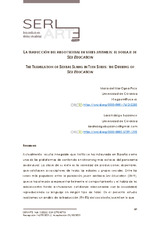Mostrar el registro sencillo del ítem
La traducción del argot sexual en series juveniles: el doblaje de Sex Education
| dc.contributor.author | Ogea Pozo, María del Mar | |
| dc.date.accessioned | 2023-01-20T08:36:36Z | |
| dc.date.available | 2023-01-20T08:36:36Z | |
| dc.date.issued | 2022 | |
| dc.identifier.issn | 2792-8713 | |
| dc.identifier.uri | http://hdl.handle.net/10396/24542 | |
| dc.description.abstract | Actualmente, resulta innegable que Netflix se ha instaurado en España como una de las plataformas de contenido en streaming más exitosas del panorama audiovisual. La clave de su éxito es la variedad de producciones disponibles, que satisfacen a suscriptores de todas las edades y grupos sociales. Entre las series más populares entre la población joven destaca Sex Education(2019), que se ha atrevido a representar fielmente el comportamiento y el habla de los adolescentes frente a situaciones cotidianas relacionadas con la sexualidad, reproduciendo su lenguaje sin ningún tipo de tabú. En el presente estudio realizamos un análisis de la traducción (EN-ES) del sociolecto juvenil en lo que respecta al argot sexual, con el fin de determinar el registro lingüístico predominante tanto en la cultura británica como en la española, así como los niveles de intensidad de la terminología empleada en ambas lenguas. Finalmente, evaluamos el efecto causado por la presencia del lenguaje sexual entre el público joven español para comprobar si el doblaje proporciona el mismo grado de naturalidad y adecuación del sociolecto, de modo que asegure el éxito de Sex Education entre sus consumidores. | es_ES |
| dc.description.abstract | Nowadays, Netflix has clearly established itself in Spain as one of the most successful VOD platforms in the audiovisual scene. The key to its success is the variety of productions available, which satisfy subscribers of all ages and social groups. One of the most popular series among the young population is Sex Education (2019), a series that has dared to faithfully represent the behaviorand speech of teenagers in daily situations related to sexuality, reproducing their language with no taboo. Inthe present study, we conduct an analysis of the translation (EN-ES) of the youth sociolect in terms of sexual slang, in order to determine the predominant linguistic register in both British and Spanish cultures, as well as the levels of intensity of theterminology used in both languages. Finally, we evaluate the impact of sexual slangamong the young Spanish audience to ascertain whether dubbing provides the same degree of naturalness and adequacy of the sociolect, so as to ensure the success of Sex Educationamong its consumers. | es_ES |
| dc.format.mimetype | application/pdf | es_ES |
| dc.language.iso | spa | es_ES |
| dc.publisher | UCOPress | es_ES |
| dc.rights | https://creativecommons.org/licenses/by-nc-sa/4.0/ | es_ES |
| dc.source | Seriarte 1, 90-114 (2022) | es_ES |
| dc.subject | Series | es_ES |
| dc.subject | Sex Education | es_ES |
| dc.subject | Lenguaje sexual | es_ES |
| dc.subject | Tabú | es_ES |
| dc.subject | Lenguaje juvenil | es_ES |
| dc.subject | Doblaje | es_ES |
| dc.subject | Traducción audiovisual | es_ES |
| dc.subject | Sex language | es_ES |
| dc.subject | Taboo | es_ES |
| dc.subject | Teen slang | es_ES |
| dc.subject | Dubbing | es_ES |
| dc.subject | Audiovisual translation | es_ES |
| dc.title | La traducción del argot sexual en series juveniles: el doblaje de Sex Education | es_ES |
| dc.title.alternative | The translation of sexual slang in teen series: the dubbing of Sex Education | es_ES |
| dc.type | info:eu-repo/semantics/article | es_ES |
| dc.relation.publisherversion | https://journals.uco.es/index.php/seriarte | |
| dc.rights.accessRights | info:eu-repo/semantics/openAccess | es_ES |

